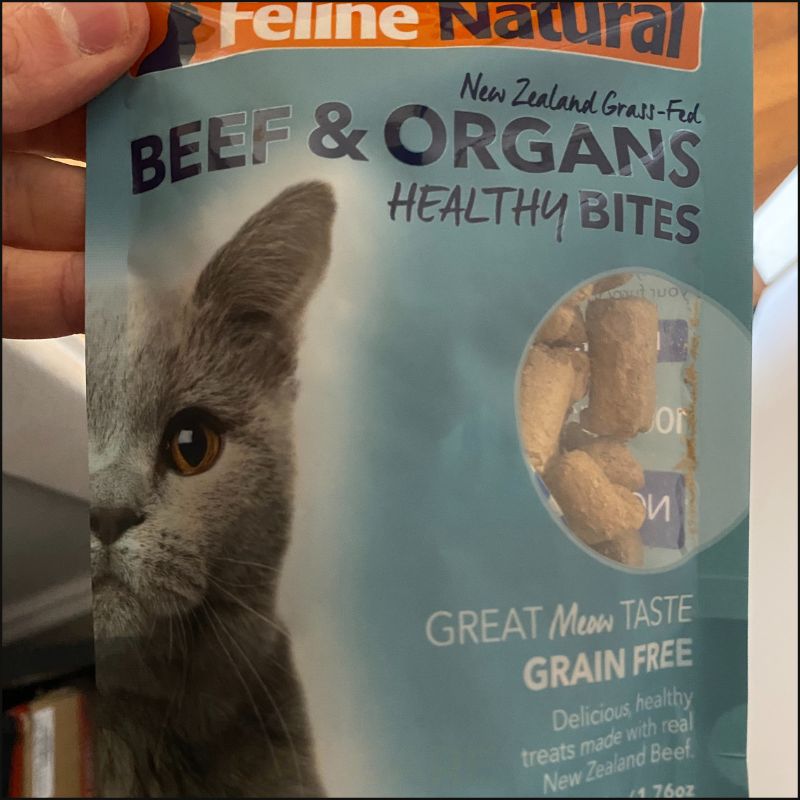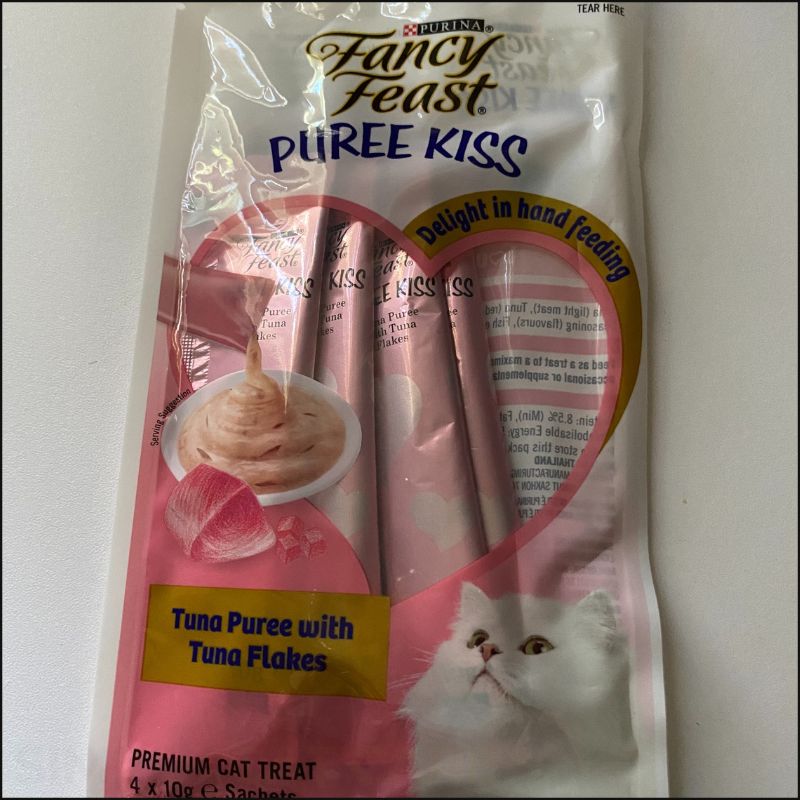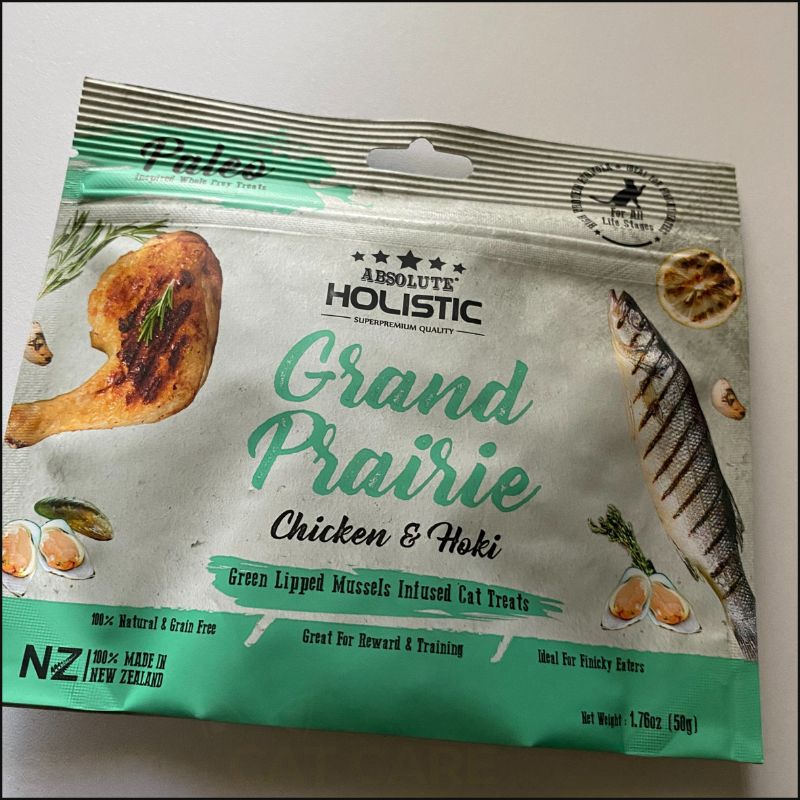Quick answer: Cats are carnivores and only need meat.
Aim for treats that are packed with animal based ingredients for overall health.
Treats are designed to supplement the diet and only make 10% of the diet.
Best options:
3 Best Cat Treats in Australia
I filtered popular cat treats in Australia for quality. All are the best rated from my testing.
More below in this guide to the best cat treats in Australia.
I have a background in nutrition and research and test most of the products recommended.
This article isn’t a replacement for medical advice.
See more about us here.
I went out and bought 10 Australian cat treats to see what my 4 kittens liked best and what was best for health.
Feline Natural comes out on top as the healthiest and overall best treat.
It’s packed with meat and organs, which cats love as carnivores. And there’s no fillers like rice, so you’re good there.
This treat is soft and crumbly, which is great for kittens and senior cats with poor dentition.
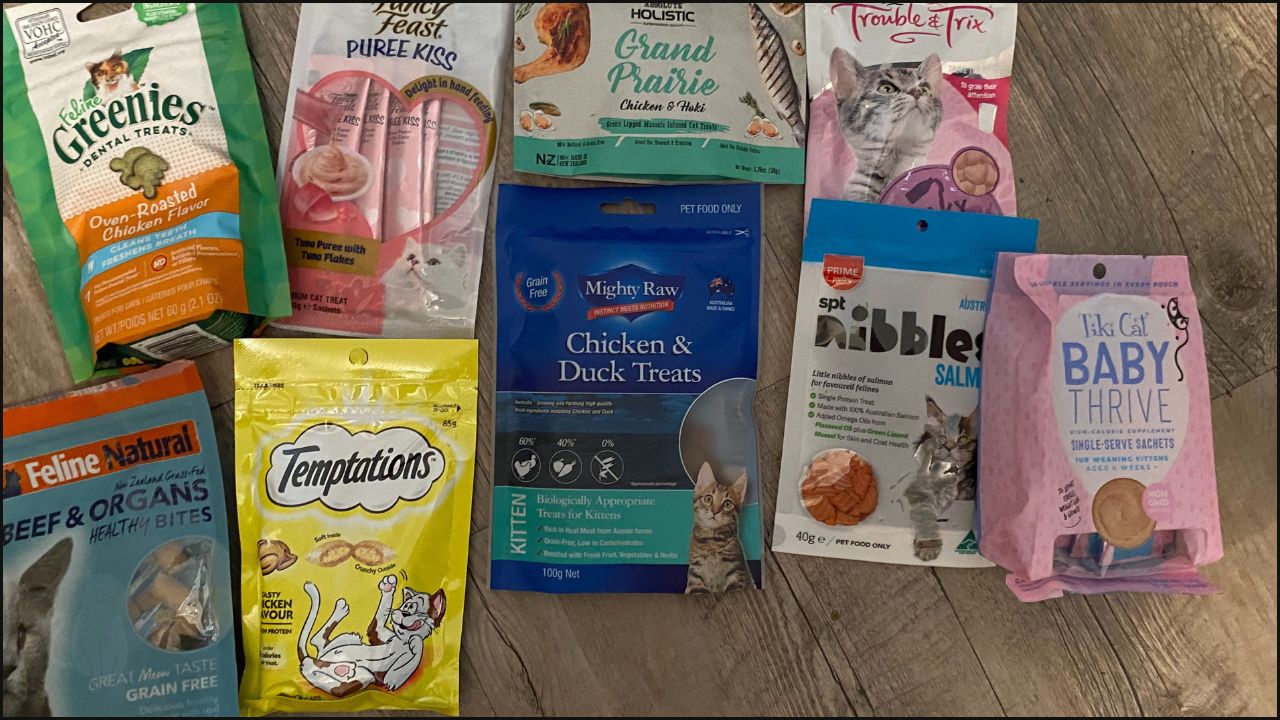
What to Look for in Cat Treats?
Quick answer:
- Meat Based: Cats are carnivores. Meat based treats are highly palatable and nutritious, being high in protein.
- Best Treats: Air-dried treats and freeze dried treats with real meat of fish help assist cats meeting their nutritional needs. They typically come in bite-sized pieces and contain minimal fillers and may also contain essential vitamins and minerals.
- What are Dental Treats? These are designed to help clean cats teeth by removing plaque and tartar (although less effective than brushing). Not really needed.
- Picky Eaters? Try lickable cat treats. For training sessions that are easy to reward and usually high fat, which is often more palatable to cats.
- Best Foods for Treats: Salmon is an excellent option as cats enjoy the taste and it’s rich in omega 3 fatty acids for joint health.
- Treats for Kittens: Kitten taste preferences are influenced by their mother. Check what the mother cat likes for clues and look for soft treat options (freeze-dried is great as you can crumble it down).
- Avoid Fruits: Fruit is NOT an appropriate treat (despite what Google says), as it doesn’t contain protein. One meal without arginine can have serious consequences for cats, leading to hyper-ammonia and potentially even DEATH.
- Grain-Free? Some cats are sensitive to grain ingredients (e.g. wheat), causing food intolerance. Cats do not need grains, so gluten free may help with digestion.
- Allergies? Single protein cat treats with novel protein (e.g. lamb, venison) are the right treats for this. Ziwi Peak make a few air-dried novel protein cat foods.
- Nutritional Adequacy: Most treats are NOT complete foods and don’t have the complete range of nutrients kitty needs. Limit most treats to 10% of the diet, to make sure they don’t displace main meals. Some treats are complete meals, meaning you can make them stand alone meals. Check the label.
Long answers:
What Are the Healthiest Treats to Give Your Cat?
Cats are carnivores which means their natural diet is meat based.
A cat prefers and thrives off meats, organs, and bones over carb rich foods.
Check the ingredients list. The ingredients list by weight, so the higher and ingredient – the more of it there is.
Since you want to give your cat meat, you’ll want to see that as the main ingredient and not something like grains.
This is a quick way to know you’re feeding your cat a quality treat that they’ll enjoy.
Tl;dr:
- Cats are carnivores.
- A good treat is a meat based treat.
- Check the ingredients and look for meat high on the list (preferably first).
Do Cats Really Need Treats?
Cats do not need treats.
However, there might be benefits to giving cats treats.
Cat treats may help reinforce the use of a litter tray to help prevent inappropriate house soiling, although experts aren’t clear on the benefit.
Another benefit is using cat treats with a puzzle toy (e.g. ball), helping to encourage play.
Treats can also help the process of socializing kittens.
Finally, they can help with giving cats medication in a tasty and palatable way (e.g. with a liquid puree treat).
Tl;dr:
- Cats do no need treats.
- However, treats can help reinforce positive behavior (e.g. using the litter tray).
- Treats could help with giving cats medication (check with a vet).
Things to Look for in Cat Treats
Here are some things to look for when choosing a treat for your cat.
Texture and Size
There’s many types of treats.
Some are crunchier and best suited to adult cats. Others are softer and crumbly – ideal for kittens or senior cats.
Some types to look for:
- Lickable cat treats: A squeezable tube that produces a meaty paste.
- Air-dried cat treats: Hard kibble like treats with dried meat. Usually great quality.
- Freeze-dried cat treats: Soft and crumbly. Packed with meats and organs. Great for kittens and seniors without teeth.
- Dental treats: Used to help clean cats teeth (although less effective than brushing).
There’s controversy with freeze-dried treats as they’re considered raw and may harbor bacteria.
I only saw one recall of a freeze-dried cat food (from Primal), due to bone fragment size ‘deviated from ideal’.
Taste and Flavors
Look at the ingredients.
Is your cat a fish lover, or a chicken enjoyer?
Kitten taste preferences are influenced by their mother. Check what the mother cat likes for clues.
Most cats enjoy variety, but they also get set in their ways.
Research finds cats enjoy salmon, a great option for picky cats. Cats enjoy the taste of salmon, which is rich in omega 3 fatty acids
Ingredients to Avoid
Check the ingredient list.
Many cat treats contain a wide variety of fillers, similar to human food ‘treats’.
Some cats are sensitive to grain ingredients (e.g. wheat), causing food intolerance.
Stick with meat rich treats for sensitive stomachs. Freeze-dried and air-dried treats are usually best.
Also avoid toxic foods.
A quick google search showed that many sites recommend fruit for cats. As carnivores, cats do not need (or want) to eat fruit.
Not only that, but a fruits may not contain enough arginine (an amino acid high in meat and dairy). Why does that matter?
One meal without arginine can have serious consequences for cats, leading to hyper-ammonia and potentially even death. Fruits aren’t appropriate as treats for cats (despite the Google search results).
Lifestage Appropriate Cat Treats
Most treats are supplemental.
That means they don’t have the nutrition cats need. Limit most treats to 10% of the diet, to make sure they don’t displace main meals.
However, some treats are complete meals, meaning you can make them stand alone meals. Check the label.
Check for Samples
Try before you buy.
Sometimes you can get sample packs to try from cat food websites or retail stores.
It never hurts to ask if they’re offering anything to try a range of treats before committing to a purchase.
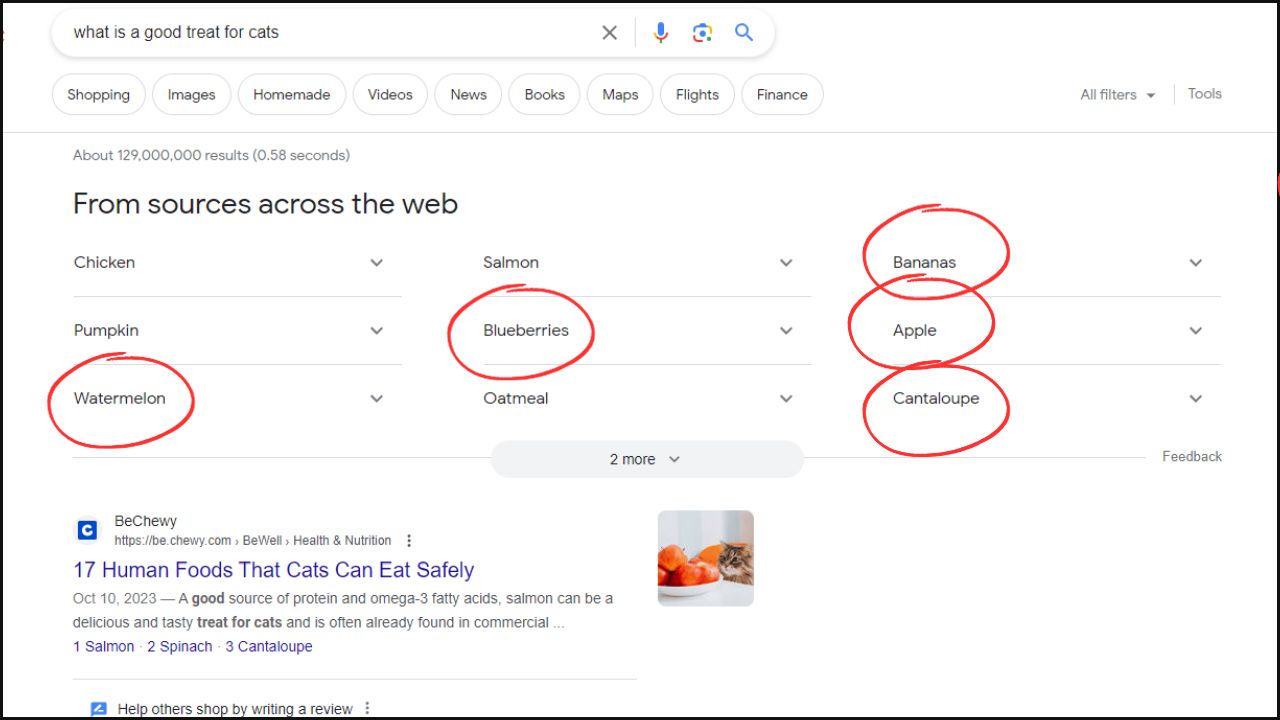
FAQ
Quick answers:
- Best Treat if Cat Doesn’t Like? Try liquid treats, they tend to be the tastiest training treats in our experience.
- Are Treats Bad? Too many treats can increase calories and lead to weight gain. Avoid free-feeding treats and limit to less than 10% of the diet.
- Best Dental Treats? Greenies.
- Can I Give Cats Treats Everyday? No more than 10% of the diet.
- Human Food Treats for Cats? Very occasional use of plain meat, chicken or fish may be an ok natural treat for cats occasionally (no seasoning). DO NOT give cats FRUIT or anything else as this may be toxic.
Long answers:
What Are the Best Cat Treats for Cats Who Don’t Like Treats?
We tested 10 Australian cat treats side-by-side with 4 kittens to find out what they liked best.
They enjoyed Fancy Feast Puree Kiss and Tiki Cat Baby Thrive the most (two liquid treats).
Customers report that Greenies is the cat treat that cats like most.
Online reviews show Greenies dental treats average around 4.8/5 (as of the writing of this article).
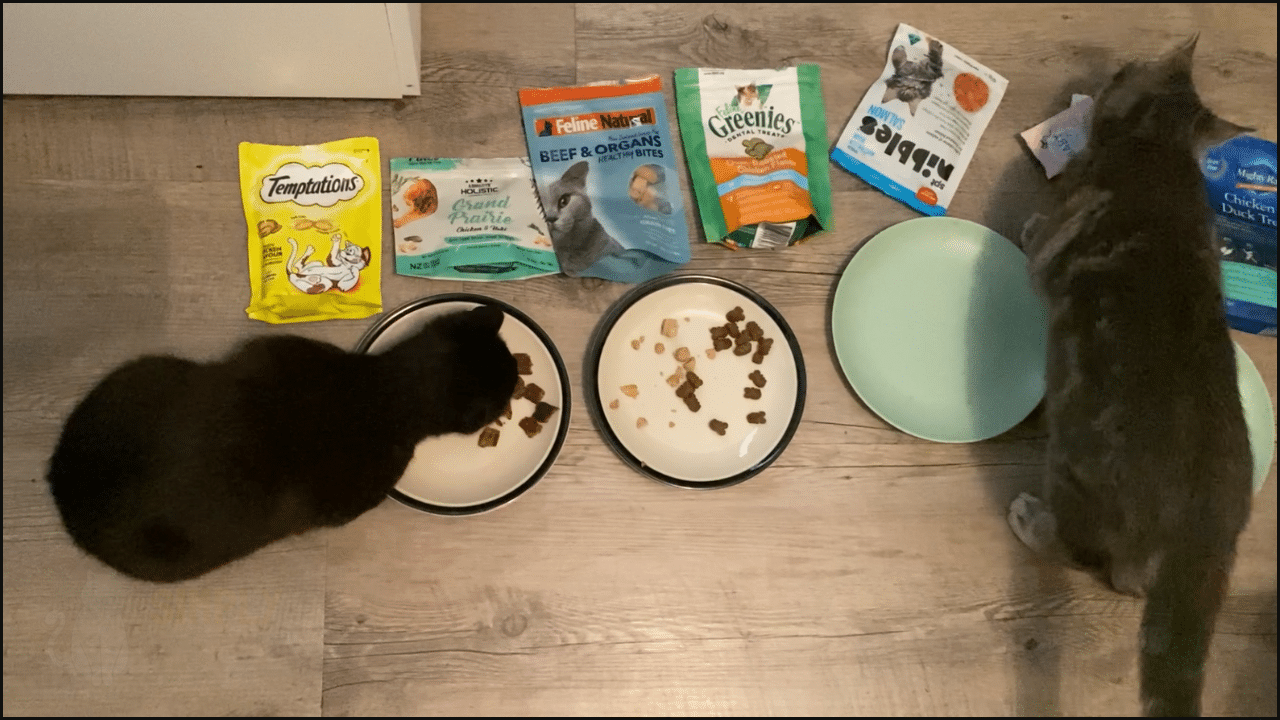
What Are the Disadvantages of Cat Treats?
Too many treats may lead to weight gain.
A sample of UK cat owners found more overweight cats with 3 treats a week (although less obesity seen with more than 4 treats a week). Treats increase calories.
Free-feeding, middle age (7-12 years) and neutering are more predictive towards weight gain. Some sources suggest 10% of the dietary intake as a limit.
What Are the Best Dental Treats for Cats in Australia?
Absolute Holistic is the best in my opinion.
Customers report that Greenies is the cat treat that cats like most.
Online reviews show Greenies dental treats average around 4.8/5 (as of the writing of this article).
Are Greenies Cat Treats Safe for Cats?
Greenies are formulated treats that meet the dietary requirements of cats. They meet the specific dietary needs of cats are safe to use in moderation.
Can I Give My Cat Treats Everyday?
Cats can have treats everyday.
However, aim to offer no more than 10% of your cats total calories from treats. Too many calories leads to weight gain.
How Do I Choose Cat Treats?
What’s your goal?
Is the treat for training your cat? Try lickable cat treats as they are easy for this purpose.
Are you trying to help form a balanced diet? Use freeze-dried or air-dried natural cat treats made with meat or fish.
Food allergies? Try single protein novel cat treats (e.g. lamb, venison).
Do Cats Really Need Treats?
No, cat’s do not need treats for overall health and well-being.
They are an option for cats for training or small contribution as part of a balanced diet. They’re helpful for socializing kittens, but not essential.
What Treats Should Cats Avoid?
Foods to avoid include:
- Fruit
- Yeast
- Garlic
- Onions
- Avocado
- Chocolate
Do NOT give a cat fruit.
Related:
What Treats Should Cats Avoid?
Foods to avoid include:
- Fruit
- Yeast
- Garlic
- Onions
- Avocado
- Chocolate
Do NOT give a cat fruit.
What Human Food Is a Treat for Cats?
If you run out of cat food it’s best to get more as soon as possible.
Whilst cats are carnivores and can eat plain meat (e.g. tuna in springwater, poached plain chicken breast without seasoning) these foods aren’t complete sources of nutrition.
Over a long period, the lack of nutrient variety will lead to deficiency with nasty side-effects.
You cannot feed cats meat free meals as it can lead to death.
Can Cats Have Cheese?
As an occasional treat, cats may have cheese.
Cheese doesn’t contain lactose (which can upset digestion in cats). However it’s high in calories and might lead to weight gain.
Learn more:
What Can I Feed My Cat When I Run Out of Cat Food?
If you run out of cat food it’s best to get more as soon as possible.
Whilst cats are carnivores and can eat plain meat (e.g. tuna in springwater, poached plain chicken breast without seasoning) these foods aren’t complete sources of nutrition.
Over a long period, the lack of nutrient variety will lead to deficiency with nasty side-effects.
You cannot feed cats meat free meals as it can lead to death.
What Makes Cat Treats So Appealing to Cats?
Many cat treats are made with flavour to boost the taste.
As you’d expect, this improves the taste. Avoid treats where there is little meat based ingredients, which are quality ingredients for cats.
Conclusion
Treats are great for occasional feeding and positive reinforcement.
Limit treats to no more than 10% of the diet as too many treats can lead to weight gain.
We found the quality drops off quickly, with most options lackluster in nutrition quality despite being quite tasty.
Comparison of our top 3 picks:
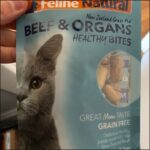
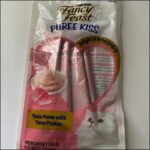

Feline Natural
Fancy Feast Puree
Absolute Holistic
See review
Related:

